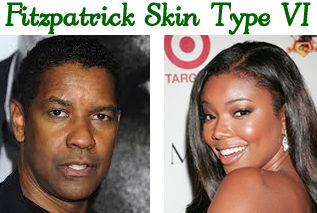People with skin type VI have a dark skin colour and usually of African decent. Their skin rarely burns and although skin cancer is not common among people with this skin type, they should still take the necessary precaution to protect their skin against skin cancer, namely wear sunscreen with a SPF higher than 15 and seek the shade between 10am and 4pm. Individuals with this skin type should still protect themselves from the sun as chronic sun exposure leads to uneven skin tone and pigmentation.
Acral lentiginous melanoma, a very virulent form of the disease, is more common among darker-skinned people. These melanomas tend to appear on parts of the body not often exposed to the sun, and often remain undetected until after the cancer has spread. Individuals should therefore check their skin regularly from head-to-toe and pay careful attention to any suspicious growths, especially on the palms, soles of the feet and on mucous membranes.
Skin type VI also reacts differently and at times more severely to common conditions such as acne, eczema, dermatitis, psoriasis and seborrheic dermatitis (dandruff) which can lead to potential problems with pigmentation, or uneven darkening or lightening of skin colour as he formation of melanin is a dynamic process and responds to various stimuli. Thus the the skin is more reactive to an insult which can lead to dark marks called Post Inflammatory Hyperpigmentation PIH. PIH may takes years to fade thus wearing a sunscreen daily, is essential to prevent PIH. This skin type can also produce less pigmentation called.
Hypopigmentation or lightened areas, after a burn or other injury.
There is a greater risk of keloid (raised, often large scars) development because darker skin has a better bed of collagen. Studies suggest that the fibroblasts which make collagen, are larger and more numerous and active. Damage to darker skin is therefore associated with a greater incidence of keloids and hypertrophic scars.

|